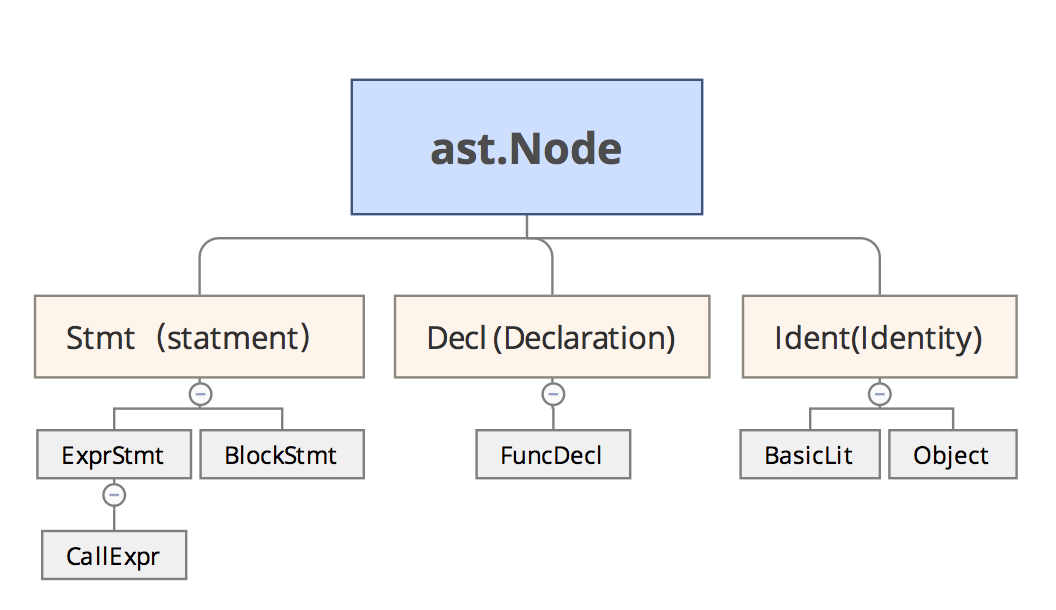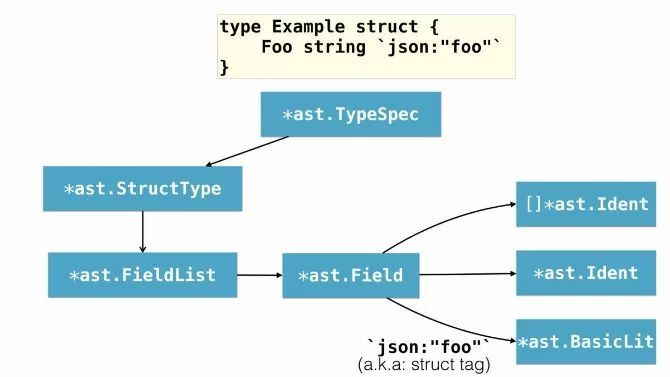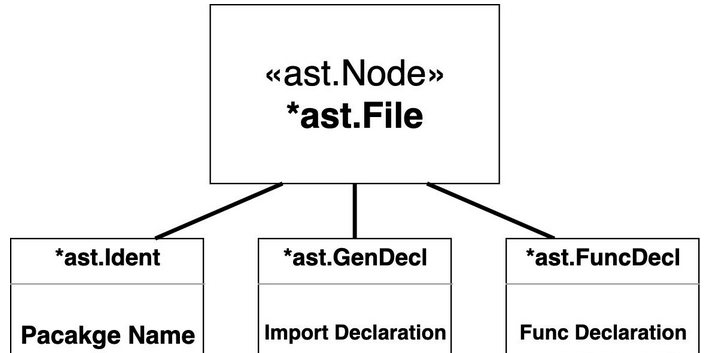AST是抽象语法树(Abstract Syntax Tree)的简称,AST以树状形式表现编程语言的语法结构,树上每个节点都表示源代码中的一种结构。之所以说语法是“抽象”的,是因为这里的语法并不会表示出真实语法中出现的每个细节。
ast包声明了用于表示Go包的语法树的类型
ast.Node
Golang会将所有可以识别的token抽象成为ast.Node,通过接口方式组织在一起。
AST节点实现了ast.Node接口,返回AST中的一个位置。
type Node interface {
Pos() token.Pos // 开始位置
End() token.Pos // 结束位置
}整个AST语法树由不同的节点组成,节点可分为三种,均会实现ast.Node接口。
-
ast.Expr代表表达式和类型的节点
type Expr interface {
Node
exprNode()
}-
ast.Stmt代表表节点
type Stmt interface {
Node
stmtNode()
}-
ast.Decl代表声明节点
type Decl interface {
Node
declNode()
}
ast.Node
示例

使用ast.Node表示结构体
package test
import (
"go/ast"
"go/parser"
"go/token"
"testing"
)
func TestAst(t *testing.T) {
src := `
package main
func main(){
println("hello world")
}
`
//创建用于解析源文件的对象
fileset := token.NewFileSet()
//解析源文件,返回ast.File原始文档类型的结构体。
astfile, err := parser.ParseFile(fileset, "", src, 0)
if err != nil {
panic(err)
}
//查看日志打印
ast.Print(fileset, astfile)
}0 *ast.File {
1 . Package: 2:1
2 . Name: *ast.Ident {
3 . . NamePos: 2:9
4 . . Name: "main"
5 . }
6 . Decls: []ast.Decl (len = 1) {
7 . . 0: *ast.FuncDecl {
8 . . . Name: *ast.Ident {
9 . . . . NamePos: 3:6
10 . . . . Name: "main"
11 . . . . Obj: *ast.Object {
12 . . . . . Kind: func
13 . . . . . Name: "main"
14 . . . . . Decl: *(obj @ 7)
15 . . . . }
16 . . . }
17 . . . Type: *ast.FuncType {
18 . . . . Func: 3:1
19 . . . . Params: *ast.FieldList {
20 . . . . . Opening: 3:10
21 . . . . . Closing: 3:11
22 . . . . }
23 . . . }
24 . . . Body: *ast.BlockStmt {
25 . . . . Lbrace: 3:12
26 . . . . List: []ast.Stmt (len = 1) {
27 . . . . . 0: *ast.ExprStmt {
28 . . . . . . X: *ast.CallExpr {
29 . . . . . . . Fun: *ast.Ident {
30 . . . . . . . . NamePos: 4:2
31 . . . . . . . . Name: "println"
32 . . . . . . . }
33 . . . . . . . Lparen: 4:9
34 . . . . . . . Args: []ast.Expr (len = 1) {
35 . . . . . . . . 0: *ast.BasicLit {
36 . . . . . . . . . ValuePos: 4:10
37 . . . . . . . . . Kind: STRING
38 . . . . . . . . . Value: "\"hello world\""
39 . . . . . . . . }
40 . . . . . . . }
41 . . . . . . . Ellipsis: -
42 . . . . . . . Rparen: 4:23
43 . . . . . . }
44 . . . . . }
45 . . . . }
46 . . . . Rbrace: 5:1
47 . . . }
48 . . }
49 . }
50 . Scope: *ast.Scope {
51 . . Objects: map[string]*ast.Object (len = 1) {
52 . . . "main": *(obj @ 11)
53 . . }
54 . }
55 . Unresolved: []*ast.Ident (len = 1) {
56 . . 0: *(obj @ 29)
57 . }
58 }分析方式
按照深度优先的顺序遍历AST节点,通过递归调用ast.Inspect()方法来逐一打印每个节点。
如果直接打印AST则会看到一些无法被人类阅读的东西。为了防止这种情况的发生,使用ast.Print()来实现对AST的人工读取。
func TestAst(t *testing.T) {
abspath, err := filepath.Abs("./demo.go")
if err != nil {
panic(abspath)
}
//创建用于解析源文件的对象
fset := token.NewFileSet()
//解析源文件,返回ast.File原始文档类型的结构体。
f, err := parser.ParseFile(fset, abspath, nil, parser.AllErrors)
if err != nil {
panic(err)
}
//递归调用逐一打印节点
ast.Inspect(f, func(n ast.Node) bool {
ast.Print(fset, n)
return true
})
}ast.File
-
ast.File是所有AST节点的根,仅实现ast.Node接口。
type File struct {
Doc *CommentGroup // associated documentation; or nil
Package token.Pos // position of "package" keyword
Name *Ident // package name
Decls []Decl // top-level declarations; or nil
Scope *Scope // package scope (this file only)
Imports []*ImportSpec // imports in this file
Unresolved []*Ident // unresolved identifiers in this file
Comments []*CommentGroup // list of all comments in the source file
}-
ast.File具有引用包名、导入声明、函数声明子节点。

ast.File
| 子节点 | 包名 | 描述 |
|---|---|---|
| ast.Indent | Package Name | 包名 |
| ast.GenDecl | Import Declaration | 导入声明 |
| ast.FuncDecl | Func Declaration | 函数声明 |
ast.Indent
- 一个包名可以使用AST节点类型
*ast.Indent来表示 -
ast.Indent实现了ast.Expr接口 - 所有标识符都由
ast.Indent结构来表示,主要包含了包的名称和在文件集中的源位置。
*ast.Ident {
NamePos: dummy.go:1:9
Name: "hello"
}例如:
2 . Name: *ast.Ident {
3 . . NamePos: 2:9
4 . . Name: "main"
5 . }Golang具有一个scope的概念,即源文件的scope,其中标识符表示指定的常量、类型、变量、函数、标签、包。
8 . . . Name: *ast.Ident {
9 . . . . NamePos: 3:6
10 . . . . Name: "main"
11 . . . . Obj: *ast.Object {
12 . . . . . Kind: func
13 . . . . . Name: "main"
14 . . . . . Decl: *(obj @ 7)
15 . . . . }
16 . . . }ast.GenDecl
-
ast.GenDecl表示除函数以外的所有导入声明,即import、const、var、type。 -
Tok代表一个词性标识,用于指明声明的内容。
*ast.GenDecl {
TokPos: dummy.go:3:1
Tok: import
Lparen: -
Specs: []ast.Spec (len = 1) {
0: *ast.ImportSpec {/* Omission */}
}
Rparen: -
}ast.ImportSpec
- 一个
ast.ImportSpec节点对应一个导入声明。 -
ast.ImportSpec实现了ast.Spec接口,访问路径可以让导入路径更有意义。
*ast.ImportSpec {
Path: *ast.BasicLit {/* Omission */}
EndPos: -
}ast.BasicLit
- 一个
ast.BasicLit节点表示一个基本类型的文字,实现了ast.Expr接口。 -
ast.BasicLit包含一个token类型,可使用token.INIT、token.FLOAT、token.IMAG、token.CHAR、token.STRING。
*ast.BasicLit {
ValuePos: dummy.go:3:8
Kind: STRING
Value: "\"fmt\""
}ast.FuncDecl
- 一个
ast.FuncDecl节点代表一个函数声明,仅实现了ast.Node接口。
ast.FuncType
- 一个
ast.FuncType包含一个函数签名,包括参数、结果和func关键字的位置。
ast.FieldList
-
ast.FieldList节点表示一个Field的咧白哦,使用括号或大括号起来。 - 列表字段是
*ast.Field的一个切片,包含一对标识符和类型。
ast.BlockStmt
- 一个
ast.BlockStmt节点表示一个括号内的语句列表,实现了ast.Stmt接口。
ast.ExprStmt
-
ast.ExprStmt在语句列表中表示一个表达式,实现了ast.Stmt接口,并包含一个ast.Expr。
ast.CallExpr
-
ast.CallExpr表示一个调用函数的表达式,要查看的字段是:Fun、要调用的函数和Args、要传递给它的参数列表。
ast.SelectorExpr
-
ast.SelectorExpr表示一个带有选择器的表达式





















 857
857











 被折叠的 条评论
为什么被折叠?
被折叠的 条评论
为什么被折叠?








